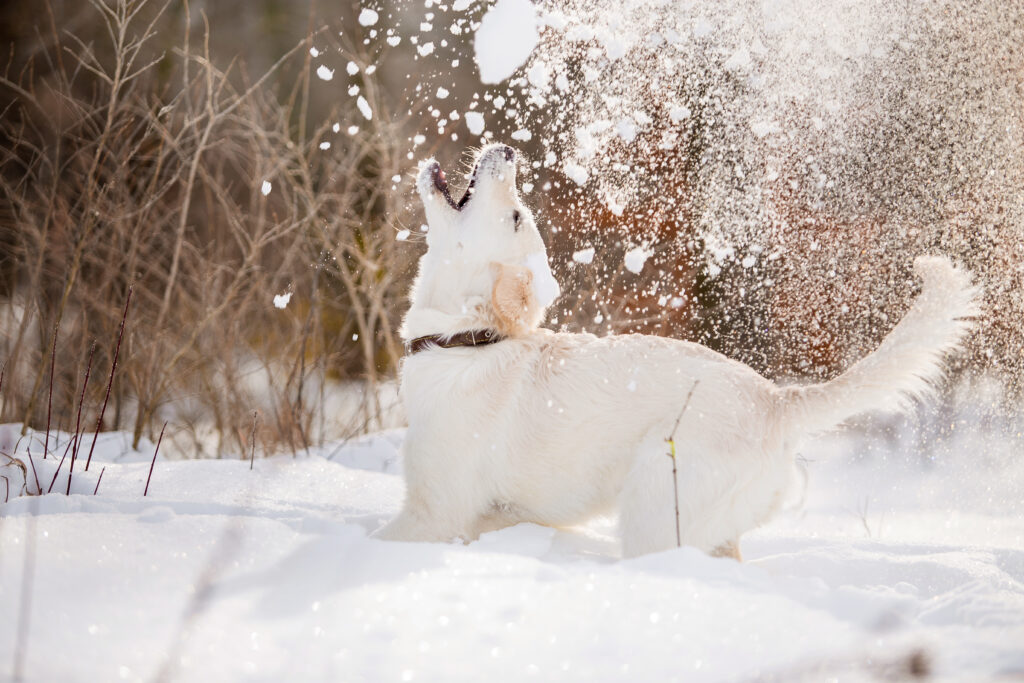Frostbite in dogs is a real concern, not just a human issue. It occurs when dogs are exposed to freezing temperatures, causing blood vessels in their extremities – like paws, ears, and tail – to constrict. This can lead to decreased blood flow and possible tissue damage. Dogs might develop frostbite within just 30 minutes in sub-freezing temperatures. It’s important for dog owners, particularly here in Manchester, New Hampshire, to be aware of frostbite risks during the cold months.
Identifying Frostbite in Dogs: Important Signs to Look For
Even though a dog’s paws are designed to handle various terrains, they can be susceptible to frostbite in cold weather. Early detection can be challenging, but there are several symptoms pet owners should be vigilant about. These include:
- Pain when touching the dog’s paws, ears, or tail
- Swelling in the affected area
- Discolored skin, appearing pale, blue, or grayish
- Skin feels cold to the touch
- Your pet is moving stiffly and awkwardly
- Signs of blisters or ulcers on the skin
- Blackened skin, indicating dead tissue
If you observe any of these signs, immediate veterinary attention is essential.
Immediate Actions for Suspected Frostbite in Dogs
If you’re concerned that your dog has frostbite, you must act swiftly yet calmly. Bring your pet indoors to a warm place right away. Wrap them in warm blankets, avoiding direct heat sources like heating pads or hot water, which can exacerbate the injury. Don’t massage the frostbitten areas, as it might worsen the condition. Then, promptly contact Best Friends Animal Hospital in Manchester at (603) 625-2378 for guidance and to arrange for urgent veterinary care.
Preventing Frostbite in Dogs
Prevention is the best approach to protecting your dog from frostbite:
- Limit their outdoor time in cold weather.
- Ensure a warm and sheltered area for your pet, ideally indoors.
- Consider dog booties and an appropriately sized coat for outdoor time, especially if your dog is smaller and is a short-haired breed.
- Stay informed about the weather and be extra careful on extremely cold days.
- Remember, if it’s too cold for you, it’s too cold for your pet!
Are Certain Dog Breeds More Resistant to Frostbite? Understanding Canine Cold Tolerance
The resistance of some dog breeds to frostbite is closely tied to their evolutionary and breeding history. Breeds like Siberian Huskies, Alaskan Malamutes, and Saint Bernards have adapted to harsh, cold climates over centuries. These adaptations give them a better natural defense against cold weather conditions and frostbite, but it’s important to understand why and how this works.
Key Factors in Cold Weather Tolerance
Double Coat: Many cold-resistant breeds have a double coat. The undercoat is dense and woolly, acting as an insulator to retain body heat. The outer coat is longer and water-resistant, protecting the dog from snow and ice. This dual-layer system provides significant warmth and protection compared to the single-layer coats of other breeds.
Body Fat and Muscle Mass: These breeds often have higher body fat and muscle mass, providing additional insulation and warmth. This extra layer is a natural barrier against the cold, helping to maintain body temperature even in freezing conditions.
Physical Structure: Dog breeds built for cold climates typically have a more compact body structure, with shorter ears and tails, reducing the surface area exposed to cold and decreasing the risk of frostbite. Their paws are also specially adapted, with a more significant fat pad and often webbed toes, which provide better traction and insulation against the snow and ice.
Limitations and Risks: Despite these natural advantages, it’s crucial to remember that no dog is entirely immune to cold weather hazards. Prolonged exposure to extreme cold can still lead to frostbite and hypothermia, even in these breeds. Factors like age, health, and coat condition also play a role in a dog’s cold tolerance.
Breeds Less Adapted to Cold: In contrast, many dog breeds lack these protective features and are more vulnerable to cold weather. Breeds with short, thin coats, such as Greyhounds or Chihuahuas, smaller breeds, and dogs with less body fat are at a higher risk in cold environments. These dogs lose body heat quickly and lack the natural insulation required to withstand low temperatures.
Regardless of breed, monitoring your dog and taking preventive measures during cold weather is essential. Keeping an eye on temperature and weather conditions, limiting outdoor exposure, and providing appropriate winter gear like coats and booties can significantly reduce the risk of frostbite and other cold-weather injuries in all dogs.
Contact Us If You Have Questions About Frostbite in Dogs
Frostbite can lead to serious complications, so prompt veterinary care is crucial. If you spot any frostbite symptoms or if your dog has been in the cold for too long, don’t hesitate to call Best Friends Animal Hospital in Manchester at (603) 625-2378. Our facility is ready to handle such emergencies and provide the necessary treatment for your dog.





